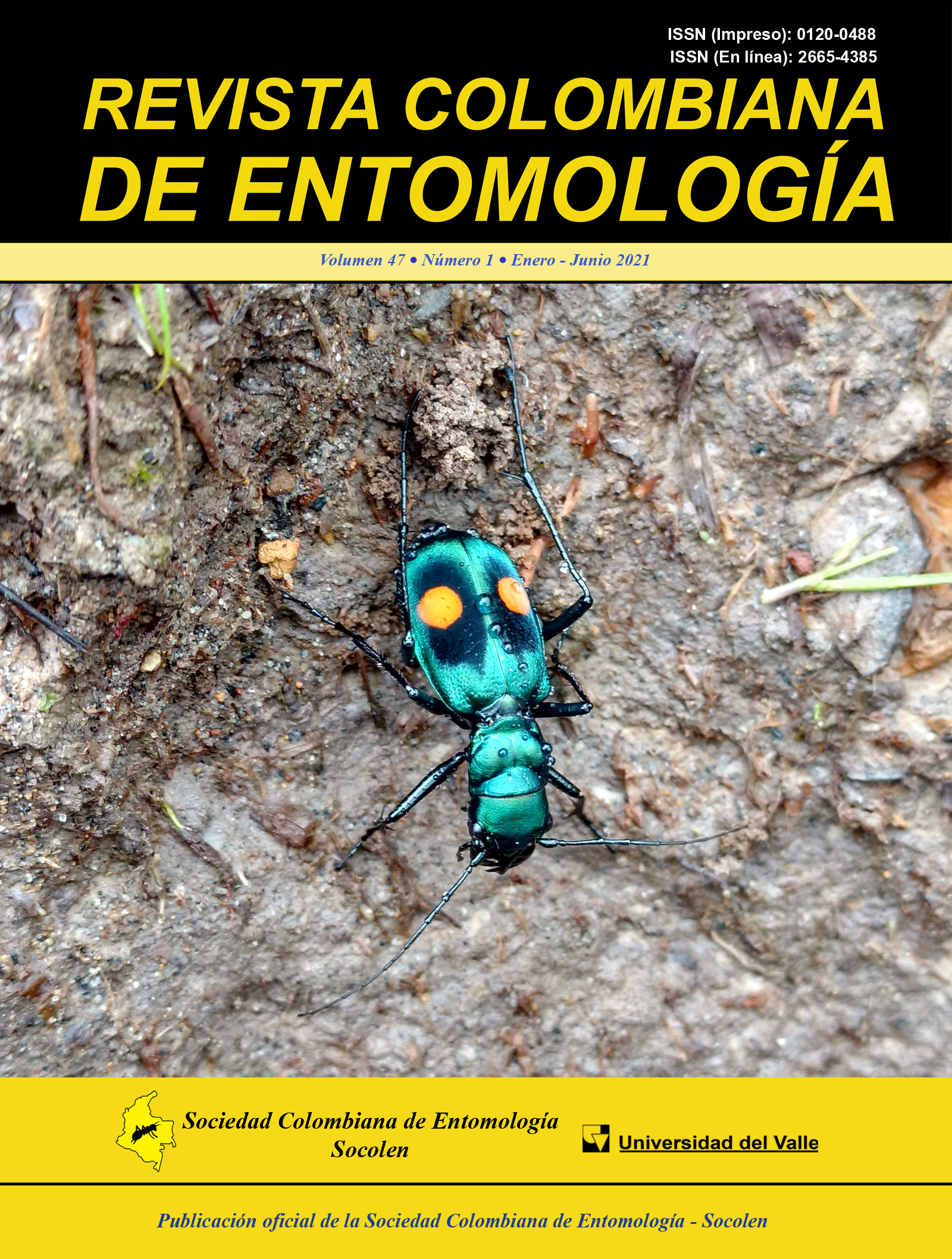Use of generalized linear models in the Leptopharsa gibbicarina (Hemiptera: Tingidae) count in oil palm
Keywords:
Over dispersion, link function, entomopathogenic fungus, quidisperssion, lace bug, Leptopharsa gibbicarinaMain Article Content
The analysis of data coming from the counting of events must consider tools that are appropriate to deal with this type of variable. A valid approach to cope with this task consists of using the Generalized Linear Model (GLM). The use of GLM allows working with density functions such as Poisson or Negative Binomial. This work presents the results of analyzing the data from an experiment carried out at the Research Station of Cenipalma located in the municipality of Barrancabermeja (Colombia). The experiment was established to evaluate, at the field level, the entomopathogenic fungus Purpureocillium lilacinum as a strategy to control the population of the lace bug, Leptopharsa gibbicarina. The experiment was carried out in two plots, in one of them, the control of L. gibbicarina with P. lilacinum was implemented as suggested by the Entomology research program of Cenipalma and, in the other plot there was no control strategy. The data were analyzed by using GLM and two different density functions (Poisson and the negative binomial). Results showed statistically significant differences between the treatments. The estimator of the maximum likelihood associated with the P. lilacinum treatment indicated that the application of the entomopathogenic fungus reduced the populations of L. gibbicarina with a rate of incidence of 0.28 times more than the control.
AGRESTI, A. 2002. Categorical Data Analysis. 2nd Edition. Jhon Wiley & Sons, Inc., Hoboken. New Jersey, EE. UU. 710 p.
ARANGO LONDOÑO, D.; ORTEGA LENIS, D.; OLAYA OCHOA, J. 2009. Modelación del número de homicidios vía regresión de Poisson. Heurística 16: 81-90. https://bibliotecadigital.univalle.
edu.co/bitstream/handle/10893/6105/Heuristica16-A07.pdf
BARRIOS, T. C. E.; BUSTILLO P., A. E.; OCAMPO R., K. L.; REINA C., M. A.; ALVARADO M., H. L. 2016. Eficacia de hongos entomopatógenos en el control de Leptopharsa gibbicarina
(Hemiptera: Tingidae) en palma de aceite. Revista Colombiana de Entomología 42 (1): 22-27. https://doi.org/10.25100/socolen.v42i1.6665
CARRILLO-RAYAS, M. T.; BLANCO-LABRA, A. 2009. Potencial y algunos de los mecanismos de acción de los hongos entomopatógenos para el control de insectos plaga. Acta Universitaria
(2): 40-49. https://doi.org/10.15174/au.2009.102
DOBSON, A. J.; BARNETT, A. G. 2018. An introduction to generalized linear models. Chapman and Hall / CRC Press. 4th Edition. Boca Raton, EE. UU. 392 p.
DRAPER, N. R.; SMITH, H. 1981. Applied regression analysis. 2nd Edition. John Wiley & Sons. New York, EE. UU. 709 p.
HINDE, J.; DEMÉTRIO, C. G. B. 1998. Overdispersion: Models and estimation. Computational Statistics & Data Analysis 27 (2): 151-170. https://doi.org/10.1016/S0167-9473(98)00007-3
KUEHL, R. O. 2000. Design of experiments: Statistical principles of research design and analysis. 2nd Edition. Duxbury/Thomson Learning. Belmont, California, EE. UU. 666 p.
LEHMANN, E. L. 2006. Nonparametrics: Statistical methods based on ranks. Springer Science & Business Media. New York, EE. UU. 463 p.
LINDSEY, J. K. 1995. Modelling frequency and count data. Oxford Science Publications/Clarendon Press. Oxford, England. 291 p.
McCULLAGH, P.; NELDER, J. A. 1989. Generalized linear models. 2nd Edition. Chapman and Hall. Londres, England. 526 p. http:// www.utstat.toronto.edu/~brunner/oldclass/2201s11/readings/glmbook.pdf
MELO MARTÍNEZ, O. O.; LÓPEZ PÉREZ, L. A.; MELO MARTÍNEZ, S. E. 2007. Diseño de experimentos: métodos y aplicaciones. Universidad Nacional de Colombia. Bogotá, Colombia.
p. https://www.uneditorial.com/bw-diseno-de-experimentos- metodos-y-aplicaciones-fisica.html MORALES, M. A.; LÓPEZ, L. A. 2009. Estudio de homogeneidad de la dispersión en diseño a una vía de clasificación para datos de proporciones y conteos. Revista Colombiana de Estadística 32 (1): 59-78. https://revistas.unal.edu.co/index.php/estad/article/
view/29754
NAVARRO, A.; UTZET, F.; PUIG, P.; CAMINAL, J.; MARTÍN, M. 2001. La distribución binomial negativa frente a la de Poisson en el análisis de fenómenos recurrentes. Gaceta Sanitaria 15 (5): 447-452. https://doi.org/10.1016/S0213-9111(01)71599-3
NELDER, J. A.; WEDDERBURN, R. W. M. 1972. Generalized linear models. Journal of the Royal Statistical Society, Series A 135 (3): 370-384. https://doi.org/10.2307/2344614
PUCHETA DÍAZ, M.; FLORES MACÍAS, A.; RODRÍGUEZ NAVARRO, S.; DE LA TORRE, M. 2006. Mecanismo de acción de los hongos entomopatógenos. Interciencia 31 (12): 856-860. Disponible en: https://www.researchgate.net/publication/ 46406133_Mecanismo_de_accion_de_los_hongos_entomopatogenos [Fecha revisión: 15 diciembre 2020]
SÄRNDAL, C-E.; SWENSSON, B.; WRETMAN, J. 2003. Model assisted survey sampling. Springer Science & Business Media. Örebro, Sweden. 694 p.
SAS INSTITUTE INC. 2008. SAS/STAT® 9.2. User’s guide, Introduction to Statistical Modeling with SAS/STAT Software. SAS Institute. Cary, North Carolina, EE. UU. 60 p. https://support.
sas.com/documentation/cdl/en/statugstatmodel/61751/PDF/default/
statugstatmodel.pdf
SILVA, A. S.; MOTA, T. A.; PIÑEYRO, N. G.; FERNANDES, M. G.; PEREIRA, F. F. 2016. Distribución espacial de Vatiga spp. (Hemiptera: Tingidae) en el cultivo de yuca. Acta Biológica
Colombiana 21 (1): 195-200. https://doi.org/10.15446/abc. v21n1.46762 TORRES BLANCO, A. M. 2011. Estudio en bloques completos vía regresión Poisson en presencia de sobredispersión. Tesis Magister en Ciencias Estadística. Universidad Nacional de Colombia, Bogotá, Colombia. 68 p. https://repositorio.unal.edu.co/bitstream/handle/unal/75303/anamariatorresb.2011.pdf?sequence= 1&isAllowed=yZAR, J. H. 1996. Biostatistical analysis. 3th Edition. Prentice Hall.
New Jersey, EE. UU. 662 p.
Downloads

This work is licensed under a Creative Commons Attribution-NonCommercial-ShareAlike 4.0 International License.
Authors retain the copyright on their work and are responsible for the ideas expressed in them. Once a manuscript is approved for publication, authors are asked for a publication license for the term of legal protection, for all territories that allows the use, dissemination and disclosure of the same.

